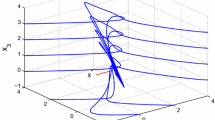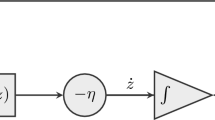Abstract
In this paper, we consider how to design a kind of nonlinear neural networks for solving the inverse optimal value problem with convex constraints. Firstly, based on optimal theory, the inverse optimal value problem considered is changed to a class of nonlinear bilevel program problems. Secondly, under the given assumptions, the corresponding nonlinear bilevel programming problem can be reduced to the one-level programming problem. Thirdly, based on the gradient theory, a nonlinear neural network model is designed to solve this one-level programming problem. Moreover, by employing Lyapunov function approach, the proposed neural network is analyzed to be globally Lyapunov stable and capable of generating approximal optimal solution to the inverse optimal value problem. Finally, two illustrative examples are provided to verify the feasibility and the efficiency of the proposed method.



Similar content being viewed by others
Explore related subjects
Discover the latest articles and news from researchers in related subjects, suggested using machine learning.References
Burton D, Toint Ph.L. (1992) On an instance of the inverse shortest paths problem. Math Program 53:45–61
Burton D, Toint Ph L (1994) On the use of an inverse shortest paths algorithm for recovering correlated costs. Math Program 63:1–22
Zhang J, Ma Z, Yang C (1995) A column generation method for inverse shortest paths problems. ZOR Math Methods Oper Res 41:347–358
Zhang J, Liu Z, Ma Z (1996) On the inverse problem of minimum spanning tree with partition constraints. ZOR Math Methods Oper Res 44:171–188
Sokkalingam PT, Ahuja R, Orlin JB (1999) Solving inverse spanning tree problems through network flow techniques. Oper Res 47:291–298
Zhang J, Liu Z (1996) Calculating some inverse linear programming problems. J Comput Appl Math 72:261–273
Zhang J, Liu Z (1999) A further study on inverse linear programming problems. J Comput Appl Math 106:345–359
Yang C, Zhang J, Ma Z (1997) Inverse maximum flow and minimum cut problems. Optimization 40:147–170
Zhang J, Cai MC (1998) Inverse problem of minimum cuts. Math Methods Oper Res 47:51-58
Ahuja RK, Orlin JB (2001) Inverse optimization. Oper Res 49:771–783
Ahuja RK, Orlin JB (2000) A faster algorithm for the inverse spanning tree problem. J Algorithm 34:177–193
Ahuja RK, Orlin JB (2002) Combinatorial algorithms for inverse network flow problems. Networks 40:181–187
Heuberger C (2004) Inverse combinatorial optimization: a survey on problems, methods, and results. J Comb Optim 8:329–361
Ahmed S, Guan Y (2005) The inverse optimal value problem. Math Program 102:91–110
Lv YB, Hu TS, Wan ZP (2008) A penalty function method for solving inverse optimal value problem. J Comput Appl Math 220:175–180
Lv YB, Chen Z, Wan ZP (2010) A penalty function method based on bilevel programming for solving inverse optimal value problems. Appl Math Lett 23:170–175
Lv YB, Chen Z, Wan ZP (2010) A neural network for solving a convex quadratic bilevel programming problem. J Comput Appl Math 234:505–511
Tong DL, Mintram R (2010) Genetic Algorithm-Neural Network (GANN): a study of neural network activation functions and depth of genetic algorithm search applied to feature selection. Int J Mach Learn Cybern 1(1-4): 75–87
Boehm O, Hardoon DR, Manevitz LM (2011) Classifying cognitive states of brain activity via one-class neural networks with feature selection by genetic algorithms. Int J Mach Learn Cybern 2(3):125–134
Graaff AJ, Engelbrecht AP (2012) Clustering data in stationary environments with a local network neighborhood artificial immune system. Int J Mach Learn Cybern 3(1):1–26
Sarlin P (2011) Visual tracking of the millennium development goals with a fuzzified self-organizing neural network. Int J Mach Learn Cybern. doi:10.1007/s13042-011-0057-5
Tsang ECC, Wang XZ, Yeung DS (2000) Improving learning accuracy of fuzzy decision trees by hybrid neural networks. IEEE Trans Fuzzy Syst 8 (5): 601–614
Wu H, Wang K, Li N, Wu C, Guo Q, Xu G (2012) Applications of the general nonlinear neural networks in solving the inverse optimal value problem with linear constraints. Inf Technol J 11:713–718
Tarantola A (1987) Inverse problem theory: methods for data fitting and model parameter estimation. Elsevier, Amsterdam, The Netherlands
Wang XJ, Feng SY (1995) The optimality theory of bilevel system. Science Publishers, Beijing
Dempe S (2002) Foundation of bilevel programming. Kluwer Academic Publishers, London
Acknowledgments
The authors are extremely grateful to the Editor and the Reviewers for their valuable comments and suggestions, which help to enrich the content and improve the presentation of this paper.
Author information
Authors and Affiliations
Corresponding author
Additional information
This work was supported by the Natural Science Foundation of Hebei Province of China (A2011203103) and the Hebei Province Education Foundation of China (2009157).
Rights and permissions
About this article
Cite this article
Wu, H., Wang, K., Guo, Q. et al. Design of a kind of nonlinear neural networks for solving the inverse optimal value problem with convex constraints. Int. J. Mach. Learn. & Cyber. 5, 85–92 (2014). https://doi.org/10.1007/s13042-012-0138-0
Received:
Accepted:
Published:
Issue Date:
DOI: https://doi.org/10.1007/s13042-012-0138-0




